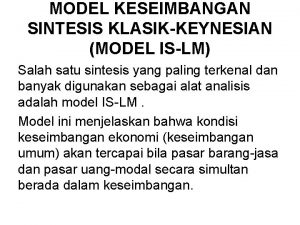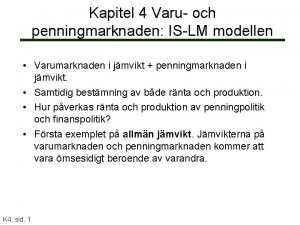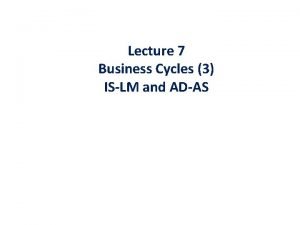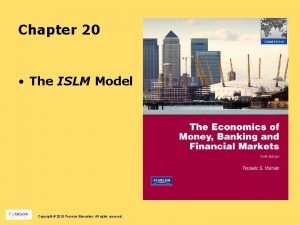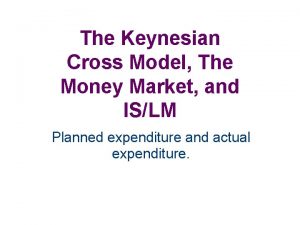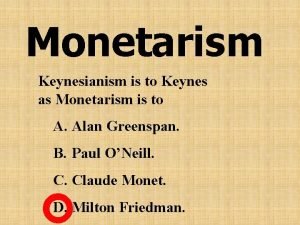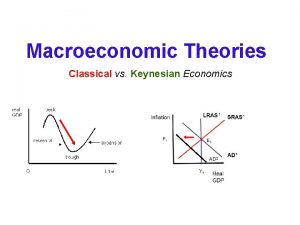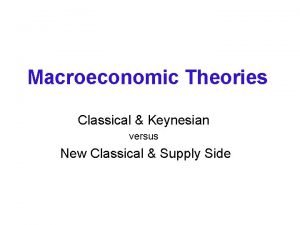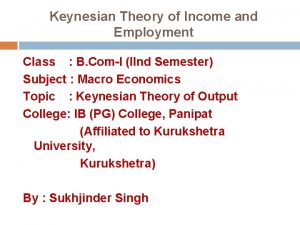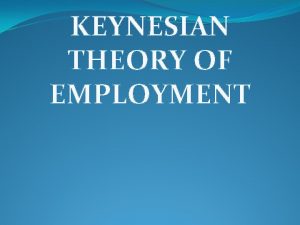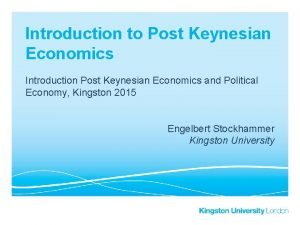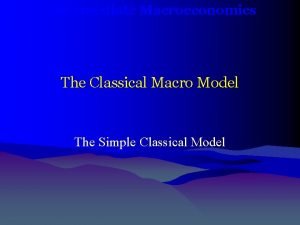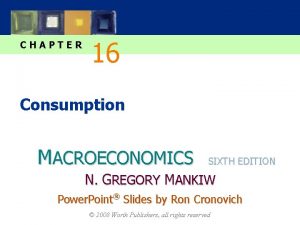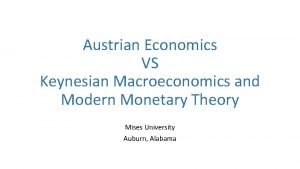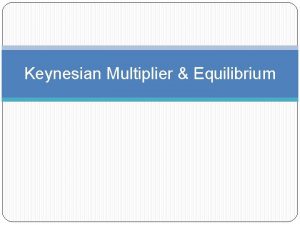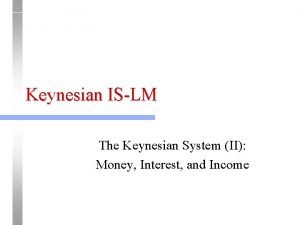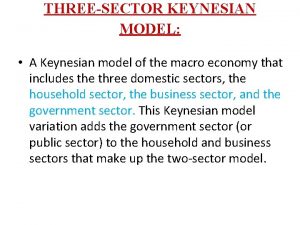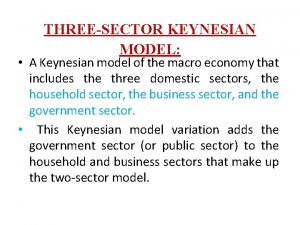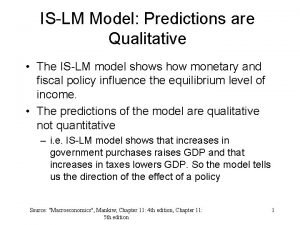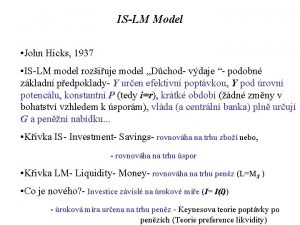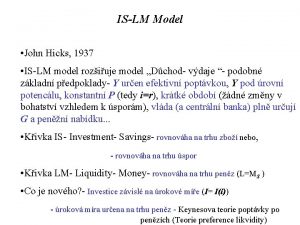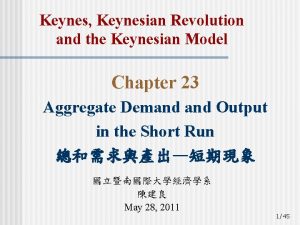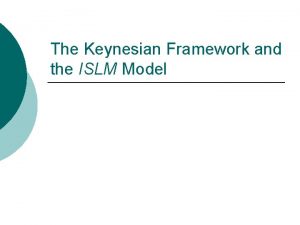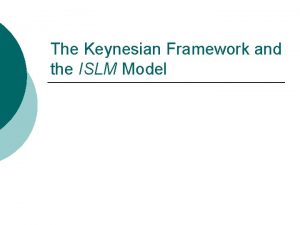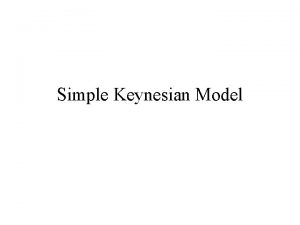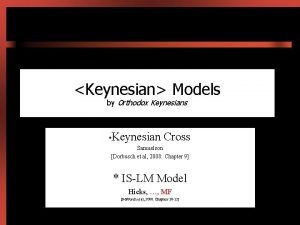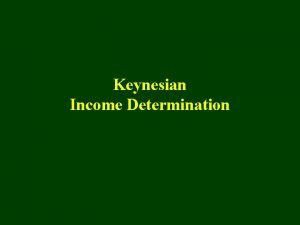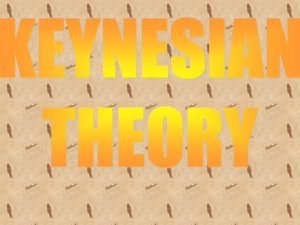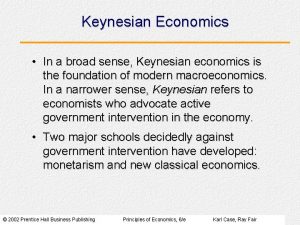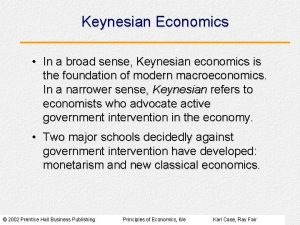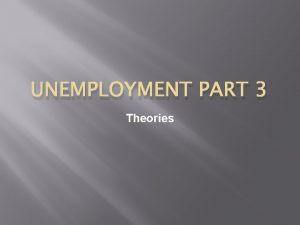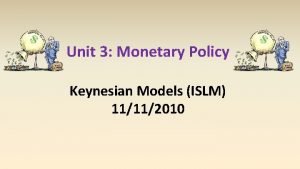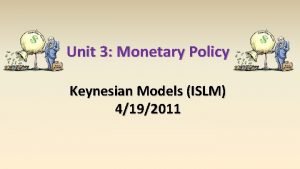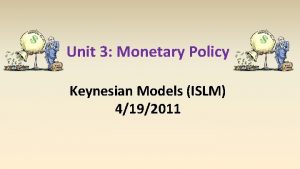ISLM MODEL Miscellaneous 1 Simple Keynesian Model v






























- Slides: 30

IS-LM MODEL Miscellaneous 1

Simple Keynesian Model v. s. IS-LM Model G’ (b = 0) C, I, G, G’, AD Slope = s/b = r b = I/ r = 0 IS 1 Y (C’-c. T’+I’+G’)/s IS 2 LM Y 2

Simple Keynesian Model v. s. IS-LM Model G’ (b = 0) n Simple Keynesian Model n n Ye = k. E G’ = G’/s IS-LM Model Ye = k. E G’ = G’/s n interest rate has increased but investment would not decrease since b=0, i. e. , investment is perfectly interest inelastic n No crowding-out effect n 3

Simple Keynesian Model v. s. IS-LM Model G’ (b 0) C, I, G, G’, I’, AD r Slope = s/b IS 1 IS 2 Y Y (C’-c. T’+I’+G’)/s LM (C’-c. T’+I’+G’)/s 4

Simple Keynesian Model v. s. IS-LM Model G’ (b 0) n Simple Keynesian Model n n Ye k. E G’ G’/s IS-LM Model Shift of the IS curve: Y = k. E G’ = G’/s n Ye k. E G’ G’/s n interest rate has increased and investment would decrease since b 0, 1 n the IS-LM multiplier = Ye/ G’ = s+b (d/e) n crowding-out effect n 5

Simple Keynesian Model v. s. IS-LM Model G’ (e = ) C, I, G, G’, AD r Slope = d/e = 0 IS 1 IS 2 e = Ma/ r = Liquidity Trap d = Mt/ Y = 0 LM Y (C’-c. T’+I’+G’)/s Y 6

Simple Keynesian Model v. s. IS-LM Model G’ (e = ) n Simple Keynesian Model • Ye = k. E G’ = G’/s n IS-LM Model • Ye = k. E G’ = G’/s • Mt has increased when Y , normally, interest rate has to increase to induce people to hold less Ma, as r would raise the return from holding bond • However, when there’s a liquidity trap, people’s demand for money as an asset, which provides liquidity, is unlimited (e = Ma/ r = ) , they would hold as much Ma as possible, r would remain constant, thus no crowding-out effect. 7

Simple Keynesian Model v. s. IS-LM Model G’ (d = 0 ) The diagram is the same as slide no. 6 n Simple Keynesian Model n • Ye = k. E G’ = G’/s n IS-LM Model • Ye = k. E G’ = G’/s • When there’s an increase in government expenditure, income increase by k. E G’ , but transaction demand for money would not increase (d = Mt/ Y = 0), Ma need not decrease and r need not increase. With the same interest rate, 8 there’s no crowding-out effect.

Simple Keynesian Model v. s. IS-LM Model G’ (Vertical LM) C, I, G, G’, I’, AD r IS 1 IS 2 LM Slope = d/e = d= Mt/ Y= e= Ma/ r=0 Y Y (C’-c. T’+I’+G’)/s 9

Simple Keynesian Model v. s. IS-LM Model G’ (Vertical LM) n Simple Keynesian Model • Ye = 0 n IS-LM Model • Ye = 0 • Full Crowding Out Effect • When d= Mt/ Y= , G’ Y by k. E G’ Mt by so Y has to reduce to the original level • When e= Ma/ r=0, G’ Y by k. E G’ Mt but Ma would not decrease, so Mt has to reduce to the original level to restore equilibrium in the money market 10

Simple Keynesian Model v. s. IS-LM Model G’ = T’ (b = 0) Balanced-Budget Change C, I, G, G’, T’, AD r Slope = s/b = I/ r = 0 IS 1 IS 3 IS 2 Y (C’-c. T’+I’+G’)/s LM Y 11

Simple Keynesian Model v. s. IS-LM Model n Simple Keynesian Model n n Cannot be used to analyze monetary policy IS-LM Model n Can be used to analyze monetary policy 12

Demand Curve P Slope of tangent = P/ Qd = 0 Ed = ( Qd/Qd)/( P/P) = It measures the responsiveness of Qd of a good to a change in the price of the good Ed = slope of ray / slope of tangent Qd 13

Deriving the IS Function Two-Sector Injection = Withdrawal I=S I= I’ - br r IS y-intercept =I’/b * y-intercept = I’/b x-intercept = I’/s slope =1/b slope = s/b b = I/ r I * Y C’ = 0 = S’ S = s. Y slope = s s = S/ Y J=W I=S S 14

Deriving the IS Function Four-Sector Injection = Withdrawal I+G+X=S+T+M J = G’ + X’ + I’ - br x-intercept = G’+X’+I’ slope = 1/b r * IS x-intercept slope = s/b b = I/ r * Y J W = S’ - s. T’ + M’ + s. Y J=W 15

Deriving the IS Function Three-Sector (w/ b = 0) Injection = Withdrawal I+G=S+T J = I’ + G’ What happens when there’s G’? r b = 0 = I/ r IS: * * slope =1/b = J slope = s/b = Y= x-intercept = Y W 16

Deriving the IS Function Three-Sector (w/ b = ) Injection = Withdrawal I+G=S+T b = = I/ r r slope = 1/b =0 What happens when there’s G’? IS slope = s/b = 0 r is a constant * * Y J W 17

Deriving the IS Function Three-Sector (w/ s = 0) Injection = Withdrawal I+G=S+T r * What happens when there’s G’? * IS slope = s/b = 0 Y J S = S’ s = S/ Y = 0 slope = 0 W W = S’ + T’ 18

Deriving the IS Function Three-Sector (w/ s = ) Injection = Withdrawal I+G=S+T What happens when there’s G’? r * IS slope = s/b = * Y J s= S/ Y= slope = W 19

Deriving the LM Function Ms = Md = Ma + Mt e= Liquidity Trap e = Ma/ r = slope = 1/e = 0 What happens when there’s Ms’? r LM slope = d/e = 0 * * Y Ma Mt 20

Deriving the LM Function Ms = Md = Ma + Mt d=0 r What happens when there’s Ms’? LM slope = d/e =0 * * Y Ma d = Mt/ Y = 0 Mt slope = 0 21

Deriving the LM Function Ms = Md = Ma + Mt What happens when e=0 there’s Ms’? e = Ma/ r = 0 r slope = 1/e = * LM slope = d/e = * Y Ma Mt 22

Deriving the LM Function Ms = Md = Ma + Mt d= What happens when there’s Ms’? r LM slope = d/e = * * Ma Y d = Mt/ Y = Mt slope = 23

Deriving the LM Function Ms = Md = Ma + Mt e = when r to a low level liquidity trap r LM slope = d/e * ** Ma Mt LM slope = d/e = 0 Y 24

1990 A#13 Interest Rate MA 0 MA 1 Asset demand for money Which of the following correctly explains the rightward shift of the asset demand function from MA 0 to MA 1? A. a rise in the interest rate B. a rise in the marginal efficiency of investment C. an increase in the sale of government bonds D. a rise in the risk of holding bonds n 25

1990 A#30 n Refer to the diagram below: S, I, G S = saving S I = investment G = government expenditure (I+G)’ Y = income I+G Y Which of the following statements is INCORRECT? A. The expenditure multiplier will increase B. The IS curve will shift to the right. C. The average propensity to save will increase D. There will be a rise in realized injection n 26

1991 A#5 n A monetary policy will be more effective if the liquidity preference function is more ___ and the marginal efficiency of capital function is more ___. A. elastic, elastic B. inelastic, inelastic C. inelastic, elastic D. elastic, inelastic 27

1991 A#8 n An increase in money supply will be likely to lead to an increase in national income. Which of the following would affect the extent of the change in national income? (1) the interest elasticity of investment (2) the marginal propensity of withdraw (3) the interest elasticity of demand for money A. (1) and (2) only B. (1) and (3) only C. (2) and (3) only D. All of the above 28

1992 A#2 n Which of the following will have a greater impact upon equilibrium income when there is a change in the money supply? A. the flatter the money demand curve; the steeper the investment demand curve; and the larger the MPC B. the steeper the money demand investment demand curves; and the smaller the MPC C. the flatter the money demand investment demand curves; and the larger the MPC D. the steeper the money demand curve; the flatter the investment demand curve; ; and the larger the MPC 29

1993 A#5 There’re 3 hypothetical economies. They’ve different sets of IS and LM function IS Function LM Function Economy A Y = 1000 - 500 r Y = 400 + 500 r Economy B Y = 1800 - 200 r Y = 500 + 500 r Economy C Y = 2400 Y = 700 + 500 r Suppose the central banks of the 3 economies reduce the money supply by the same amount. The national income will decrease most in __ and least in __. A. Economy A, Economy B B. Economy A, Economy C C. Economy B, Economy C D. Economy C, Economy A n 30
 Model keseimbangan keynesian
Model keseimbangan keynesian Is-lm modellen
Is-lm modellen Islm adas
Islm adas Islm
Islm Keynesian model
Keynesian model Keynesian model
Keynesian model Keynesian cross model
Keynesian cross model Keynesian cross
Keynesian cross Supply side economics vs keynesian
Supply side economics vs keynesian Monetarist vs keynesian vs classical
Monetarist vs keynesian vs classical Monetarism vs keynesianism
Monetarism vs keynesianism Neoclassical economics
Neoclassical economics Classical economics vs keynesian
Classical economics vs keynesian Monetarist vs classical economics
Monetarist vs classical economics Explain the keynesian theory of employment
Explain the keynesian theory of employment Keynesian and classical theory
Keynesian and classical theory Classical economics vs keynesian
Classical economics vs keynesian Keynesian consumption function
Keynesian consumption function Classical economics vs keynesian
Classical economics vs keynesian Keynesian vs classical vs monetarist
Keynesian vs classical vs monetarist Keynesian consumption function
Keynesian consumption function Economics keynesian vs classical
Economics keynesian vs classical New classical and new keynesian macroeconomics
New classical and new keynesian macroeconomics Austrian economics vs keynesian
Austrian economics vs keynesian New classical and new keynesian macroeconomics
New classical and new keynesian macroeconomics Definition of suppositories in pharmaceutics
Definition of suppositories in pharmaceutics Miscellaneous detail
Miscellaneous detail Miscellaneous fasteners
Miscellaneous fasteners 4 classification of tools
4 classification of tools Miscellaneous operators in javascript
Miscellaneous operators in javascript Pessaries dosage form
Pessaries dosage form
